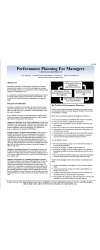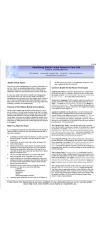Principles of Defusing Hostility
Follow these principles when dealing with an angry person to succeed!
Deal With Person’s Feelings First
An angry person needs to have the issue AND their feelings addressed in order to start interacting constructively. The angrier the person, the more important it is to acknowledge their anger through the use of empathy statements and listening responses FIRST, before moving on to the issue. Problem solving with angry people often results in wasted time unless they are ready to participate calmly.
Begin To Defuse Early
Angry and frustrated people usually indicate their mood prior to opening their mouths and beginning a hostile attack. One way to address or pre-empt the attack is to begin the defusing process before the other person gets on an abusive rant. For example, in the dialogue with Mary and Peter, Mary might have noticed Peter standing in her doorway looking rather irate and angry, and spoken first using an empathy type response like: “Hi, Peter, you look like you are really upset with something. What’s up?” Something as simple as that might have made a huge difference in setting a more respectful tone for the interaction.
Be Assertive, Not Manipulative, Passive or Aggressive
You have a right to take action, or impose consequences in situations where someone has stepped over the line in their comments or behaviours. In fact, if you don’t speak up for yourself in these situations bully-type people will perceive you as an acceptable victim for their poor behaviour. When using assertive type statements or setting up consequences, do not dwell on the way the person is communicating any more than necessary. Make your statement, then refocus the conversation back to the issue. With respect to Mary and Peter this is one way Mary might have responded.
Peter, I will help you sort this out so you have what you need. In order to help you I need you to slow down, and answer a few questions so we can get this done
Notice that the above is firm, clear and assertive. If Peter persists in being nasty or personal Mary is within her rights to say:
Peter, if you can answer my questions so we can get you those letters, I can help you. If you continue to raise your voice I’m going to have to ask you to leave. Which would you prefer?
The Critical Message: “It Isn’t Going To Work With Me
Aggressive, abusive and manipulative people look for victims they can control, using a variety of confrontation-provoking behaviour. When dealing with such people the important message to send is “What you are doing isn’t going to work with me..I will not be bullied, suckered into stupid arguments, insulted or give you the satisfaction of reacting to the abuse”. In short, it isn’t going to work with me. Once aggressive people realize that they aren’t going to be able to control you (make you angry or upset), they are more likely to aim their nasty behaviour at someone who is a better victim.
Principles of Defusing Hostility
Follow these principles when dealing with an angry person to succeed! (see BOTH parts)
If You Lose Control, You Lose, Period!
Manipulative nasty behaviour is designed to affect you emotionally so that you will become aggressive or defensive. When we lose our cool and defend ourselves or become aggressive we actually end up doing what the other nasty person wants us to do…and we lose because we enter into an ugly game where nobody can win. Self-control is critical, and that has a particular meaning. It means that we control our behaviour. You are entitled to be angry or upset if you choose but you can learn to control your behaviour and the way you express that anger or upset so something good comes from it. Here are some tips:
• When dealing with someone who is attempting to provoke a confrontation, make a conscious attempt to slow down your responses. Do NOT reply immediately since your first gut level response is likely to be an angry or defensive response. Before you respond, ask yourself the questions: “How can I deal with this situation so I create LESS anger and upset on both sides?”. Then respond.
• Pay special attention to the speed and loudness of your speech. When people get excited they tend to talk more quickly and loudly and that causes the other person to escalate also…as the conversation increases in speed there is less and less thought and more chance that people will say things that are destructive. Take your time.
• If you are really triggered, (“pi*sed off”) at what is being said to you, it is a good idea to take a time-out. A time-out is not avoidance–it differs in terms of what one says. For example, if you say: “I’m not talking about this with you” that is an avoidance response and a brush-off and likely to make the situation worse. If you say: “It isn’t a good time for me to talk about this, but I would like to discuss it with you tomorrow. Can we set up a time to meet?, that’s different because it is expressing a commitment to work with the person and does so without characterizing the conversation as negative.
What You Focus On You Get More Of
There is a general principle in life that the things you focus on you get more of. Practically speaking, that means that when someone used confrontation-provoking behaviour you have a choice as to whether you talk about the “junk” or “bait” or whether you talk about something constructive. If you focus on side-issues, personal attacks, negativity, past-centred comments, etc., THAT is what the conversation will be about. If you turn the conversation to something constructive, and do not focus on the confrontation-focusing comments, you don’t allow the attacking person a forum to continue the attacks. (see also Avoid Taking The Bait)
Avoid High Risk, High Gain Behaviour
Some reactions to nasty attacking behaviour have some chance of succeeding, but are called high risk, high gain behaviour. That is, when they work, they work well, but when they fail, they increase the level of emotion, aggression and even violence. Two examples: a verbal blunt smack upside the head, and humour. Both will work sometimes (probably rarely), and when they work they can be very effective in turning a destructive conversa tion around. The problem is when they don’t work, they increase the escalation of the conflict situation.
We tend to remember the few times when high risk, high gain actions succeed, and make the mistake of assuming that they will work again. This is usually not the case. In conflict situations it is a better bet to stay away from those kinds of actions because more often than not they backfire.
Don’t Take The Bait
We’ve left this principle to last because it is probably the most important. It ties in with several other principles we have talked about.
The term verbal bait refers to the many confrontation provoking behaviours that have a single purpose; to control and manipulate you into responding in emotional ways. When you take the bait, the “fisherperson” basically reels you in, since you have given up control of the conversation. Worse, you have given up control of the conversation to someone who probably doesn’t have your best interests at heart.
Let the bait go by. In most cases the bait has little or nothing to do with whatever is being discussed but is a conversational control ploy. As such it is best ignored. One tactic is to acknowledge the other person’s feelings, then refocus or move on to the issue you need to deal with. For example:
Vlad The Impaler: I don’t think you are competent to even have an opinion on whether we should change our filing system. Let’s face it you are one of the most unorganized people here…
Fred: “Vlad, I know you are frustrated about this. But let’s move back to the merits of the two systems we are discussing. We have the flingengaus system and the tragingf system, and need to look at the pluses and minuses…
In this example Fred has slipped the personal attacks (basically ignored them) and refocuses back to the file systems.
Some Other Comments
The process of dealing with abusive, aggressive people in the workplace can range from the simple to the very complex. We have outlined a few basic principles but there are a number of verbal techniques that can be used to defuse angry situations, prevent escalation and turn destructive conversations around. For those interested in additional resources we suggest books by Suzette Haden Elgin (Verbal Self-Defense series) or George Thompson (Verbal Judo).
Code: mxyzpickle






